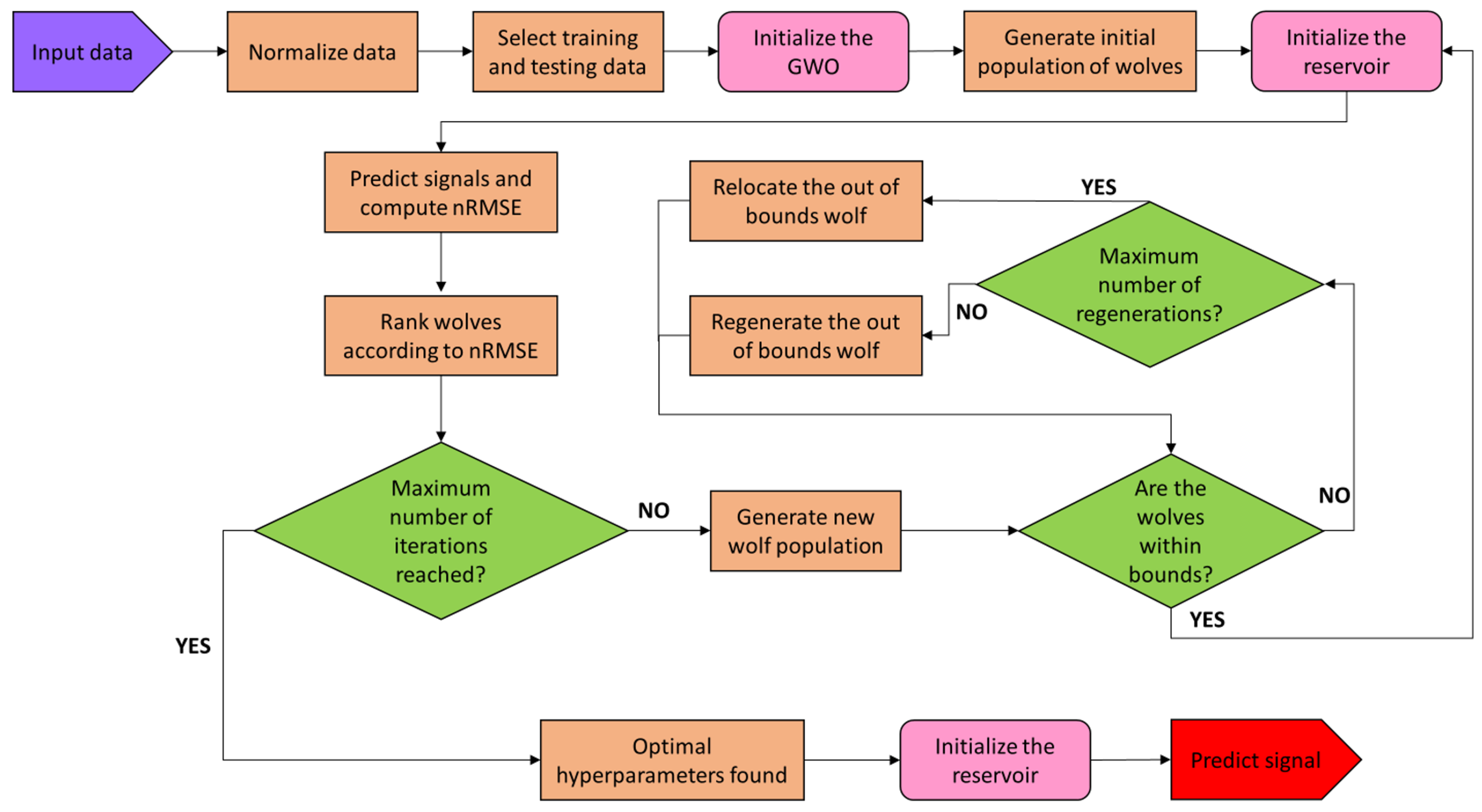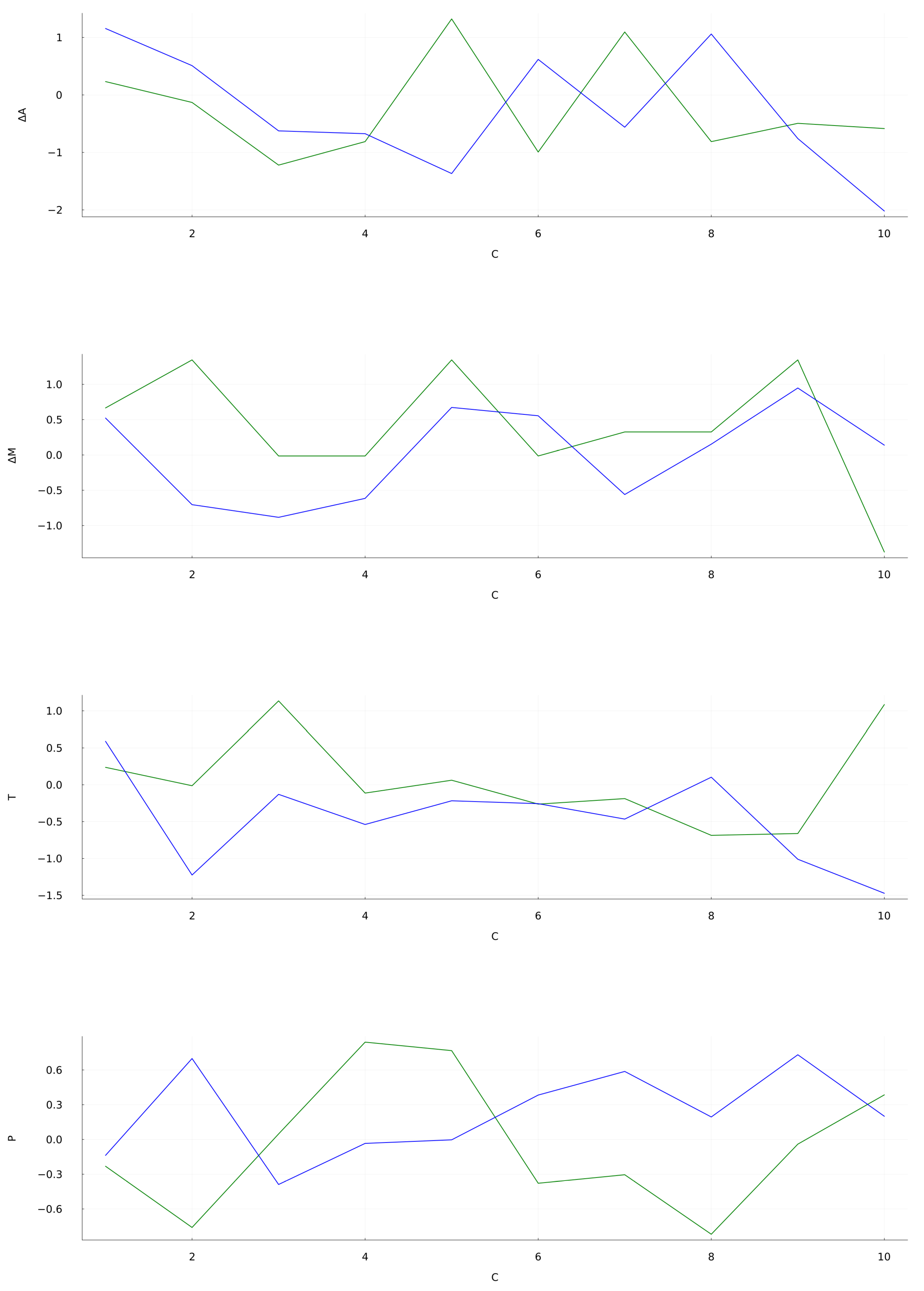Reservoir Neural Network Computing for Time Series Forecasting in Aerospace: Potential Applications to Predictive Maintenance †
Abstract
:1. Introduction
2. Materials and Methods
2.1. RC-GWO System
2.1.1. Reservoir Computing
2.1.2. Grey Wolf Optimizer
2.1.3. System Architecture
2.2. Experimental Data
3. Results
4. Conclusions
Supplementary Materials
Author Contributions
Funding
Data Availability Statement
Acknowledgments
Conflicts of Interest
Abbreviations
| ESP | Echo State Property |
| ESN | Echo State Network |
| GWO | Grey Wolf Optimizer |
| LNN | Liquid Neural Nets |
| LSM | Liquid State Machines |
| nRMSE | normalized Root Mean Square Error |
| RC | Reservoir Computing |
| RNN | Recurrent Neural Network |
References
- Zio, E. Prognostics and Health Management (PHM): Where are we and where do we (need to) go in theory and practice. Reliab. Eng. Syst. Saf. 2022, 218, 108–119. [Google Scholar] [CrossRef]
- Brunton, S. Data-Driven Aerospace Engineering: Reframing the Industry with Machine Learning. AIAA J. 2021, 59, 2820–2847. [Google Scholar] [CrossRef]
- Carvalho, T. A systematic literature review of machine learning methods applied to predictive maintenance. Comput. Ind. Eng. 2019, 137, 106024. [Google Scholar] [CrossRef]
- Gao, C. Medium and Long-Term Fault Prediction of Avionics Based on Echo State Network. Mach. Learn. Deep. Learn. Optim. Tech. Heterog. Sens. Inf. Integr. 2023, 2022, 5343909. [Google Scholar] [CrossRef]
- Rigamonti, M.; Baraldi, P.; Zio, E.; Roychoudhury, I.; Goebel, K.; Poll, S. Echo State Network for the Remaining Useful Life Prediction of a Turbofan Engine. PHM Soc. Eur. Conf. 2016, 3, 5343909. [Google Scholar] [CrossRef]
- Márquez, M.R.; Gutiérrez, E.D.; Álvarez, J.S.M.; Milton, J.G.; Cabrera, J.L. Machine learning forecasting of extreme fluctuations in a human balancing task. Knowl.-Based Syst. 2023, 280, 111000. [Google Scholar] [CrossRef]
- Lukoševičius, M. A practical guide to applying echo state networks. Lect. Notes Comput. Sci. 2012, 7700, 659–686. [Google Scholar] [CrossRef]
- Konkoli, Z. Reservoir Computing. In Encyclopedia of Complexity and Systems Science; Springer: Berlin/Heidelber, Germany, 2017. [Google Scholar] [CrossRef]
- Jaeger, H. The “echo state” approach to analysing and training recurrent neural networks-with an erratum note. In German National Research Center for Information Technology GMD Technical Report; GMD: Bonn, Germany, 2001; Volume 148, p. 13. [Google Scholar]
- Maas, W.; Natschläger, T.; Markram, H. Real-time computing without stable states: A new framework for neural computation based on perturbations. Neural Comput. 2002, 14, 2531–2560. [Google Scholar] [CrossRef] [PubMed]
- Hasani, R.; Lechner, M.; Amini, A.; Rus, D.; Grosu, R. Liquid Time Constant Networks. arXiv 2020, arXiv:2006.04439. [Google Scholar] [CrossRef]
- Pathak, J.; Hunt, B.; Girvan, M.; Lu, Z.; Ott, E. Model-Free Prediction of Large Spatiotemporally Chaotic Systems from Data: A Reservoir Computing Approach. Phys. Rev. Lett. 2018, 120, 024102. [Google Scholar] [CrossRef]
- Cai, H.; Ao, Z.; Tian, C.; Wu, Z.; Liu, H.; Tchieu, J.; Gu, M.; Mackie, K.; Guo, F. Brain organoid reservoir computing for artificial intelligence. Nat. Electron. 2023, 6, 1032–1039. [Google Scholar] [CrossRef]
- Martinuzzi, F. A Brief Introduction to Reservoir Computing. Available online: https://martinuzzifrancesco.github.io/posts/a-brief-introduction-to-reservoir-computing/#3 (accessed on 1 May 2024).
- Jaeger, H. Echo state network. Scholarpedia 2007, 2, 2330. [Google Scholar] [CrossRef]
- Mirjalili, S.; Mirjalili, S.M.; Lewis, A. Grey Wolf Optimizer. Adv. Eng. Softw. 2014, 69, 46–61. [Google Scholar] [CrossRef]
- Saxena, A.; Goebel, K.; Simon, D.; Eklund, N. Damage propagation modeling for aircraft engine run-to-failure simulation. In Proceedings of the 2008 International Conference on Prognostics and Health Management, Denver, CO, USA, 6–9 October 2008. [Google Scholar] [CrossRef]
- Prognostics Center of Excellence Data Set Repository—NASA. Available online: https://www.nasa.gov/intelligent-systems-division/discovery-and-systems-health/pcoe/pcoe-data-set-repository/ (accessed on 4 March 2024).
- Xu, M.; Baraldi, P.; Al-Dahidi, S.; Zio, E. Fault prognostics by an ensemble of Echo State Networks in presence of event based measurements. Eng. Appl. Artif. Intell. 2020, 87, 103346. [Google Scholar] [CrossRef]
- Lu, Z.; Pathak, J.; Hunt, B.; Girvan, M.; Brockett, R.; Ott, E. Reservoir observers: Model-free inference of unmeasured variables in chaotic systems. Chaos 2017, 27, 041102. [Google Scholar] [CrossRef]
- Mandal, S.; Shrimali, M.D. Achieving criticality for reservoir computing using environment-induced explosive death. Chaos 2021, 31, 031101. [Google Scholar] [CrossRef]
- Cabrera, J.L.; Hoenicka, J.; Macedo, D. A Small Morris-Lecar Neuron Network Gets Close to Critical Only in the Small-World Regimen. J. Complex Syst. 2013, 1, 675818. [Google Scholar] [CrossRef]





| Symbol | Description | Units | Dataset ID |
|---|---|---|---|
| A | Flight cruise altitude | ft | Operational Setting 1 |
| M | Flight Mach number | - | Operational Setting 2 |
| TRA | Throttle Resolver Angle | % | Operational Setting 3 |
| T2 | Total temperature at fan inlet | ° R | Sensor 1 |
| T24 | Total temperature at LPC outlet | ° R | Sensor 2 |
| T30 | Total temperature at HPC outlet | ° R | Sensor 3 |
| T50 | Total temperature at LPT outlet | ° R | Sensor 4 |
| P2 | Pressure at fan inlet | psia | Sensor 5 |
| P15 | Total pressure in bypass-duct | psia | Sensor 6 |
| P30 | Total pressure at HPC outlet | psia | Sensor 7 |
| Nf | Physical fan speed | rpm | Sensor 8 |
| Nc | Physical core speed | rpm | Sensor 9 |
| EPR | Engine Pressure Ratio (P50/P2) | - | Sensor 10 |
| Ps30 | Static pressure at HPC outlet | psia | Sensor 11 |
| Ratio of fuel flow to Ps30 | pps/psi | Sensor 12 | |
| NRf | Corrected fan speed | rpm | Sensor 13 |
| NRc | Corrected core speed | rpm | Sensor 14 |
| BPR | Bypass Ratio | - | Sensor 15 |
| farB | Burner fuel-air ratio | - | Sensor 16 |
| htBleed | Bleed Enthalpy | - | Sensor 17 |
| Nf_dmd | Demanded fan speed | rpm | Sensor 18 |
| PCNfR_dmd | Demanded corrected fan speed | rpm | Sensor 19 |
| W31 | HPT coolant bleed | lbm/s | Sensor 20 |
| W32 | LPT coolant bleed | lbm/s | Sensor 21 |
| N | c | |||||||
|---|---|---|---|---|---|---|---|---|
| Lower bound | 50 | 0.01 | 0.01 | 0.01 | 0.01 | 0.001 | 0.01 | 1 × |
| Upper bound | 500 | 0.6 | 100 | 100 | 100 | 0.3 | 0.9 | 100 |
| Set | N | c | Average nRMSE | ||||||
|---|---|---|---|---|---|---|---|---|---|
| 1 | 51 | 0.43 | 75.76 | 73.00 | 71.65 | 0.08 | 0.61 | 0.92 | 0.36 |
| 2 | 481 | 0.39 | 89.33 | 91.69 | 82.83 | 0.13 | 0.59 | 0.39 | 0.37 |
| 3 | 489 | 0.36 | 0.86 | 7.93 | 7.79 | 0.23 | 0.73 | 0.89 | 0.39 |
| 4 | 105 | 0.40 | 0.49 | 8.39 | 1.89 | 0.25 | 0.51 | 0.89 | 0.36 |
| 5 | 166 | 0.57 | 0.91 | 7.96 | 9.30 | 0.29 | 0.74 | 0.42 | 0.42 |
| Dataset ID | Set 1 | Set 2 | Set 3 | Set 4 | Set 5 | Mean |
|---|---|---|---|---|---|---|
| Operational Setting 1 | 0.35 | 0.33 | 0.44 | 0.39 | 0.42 | 0.39 |
| Operational Setting 2 | 0.48 | 0.36 | 0.31 | 0.34 | 0.36 | 0.37 |
| Operational Setting 3 | 0.00 | 0.00 | 0.00 | 0.00 | 0.00 | 0.00 |
| Sensor 1 | 0.50 | 0.32 | 0.43 | 0.50 | 0.56 | 0.46 |
| Sensor 2 | 0.40 | 0.48 | 0.47 | 0.40 | 0.51 | 0.45 |
| Sensor 3 | 0.36 | 0.46 | 0.36 | 0.38 | 0.43 | 0.40 |
| Sensor 4 | 0.39 | 0.48 | 0.52 | 0.34 | 0.47 | 0.44 |
| Sensor 5 | 0.50 | 0.32 | 0.43 | 0.50 | 0.56 | 0.46 |
| Sensor 6 | 0.36 | 0.37 | 0.35 | 0.38 | 0.42 | 0.38 |
| Sensor 7 | 0.43 | 0.43 | 0.53 | 0.36 | 0.52 | 0.45 |
| Sensor 8 | 0.43 | 0.47 | 0.52 | 0.36 | 0.54 | 0.46 |
| Sensor 9 | 0.41 | 0.47 | 0.39 | 0.38 | 0.41 | 0.41 |
| Sensor 10 | 0.50 | 0.32 | 0.43 | 0.50 | 0.56 | 0.46 |
| Sensor 11 | 0.44 | 0.44 | 0.47 | 0.38 | 0.52 | 0.45 |
| Sensor 12 | 0.39 | 0.51 | 0.52 | 0.42 | 0.53 | 0.48 |
| Sensor 13 | 0.38 | 0.49 | 0.53 | 0.46 | 0.48 | 0.47 |
| Sensor 14 | 0.36 | 0.44 | 0.45 | 0.42 | 0.47 | 0.43 |
| Sensor 15 | 0.34 | 0.48 | 0.44 | 0.43 | 0.46 | 0.43 |
| Sensor 16 | 0.50 | 0.32 | 0.43 | 0.50 | 0.56 | 0.46 |
| Sensor 17 | 0.40 | 0.43 | 0.37 | 0.36 | 0.50 | 0.41 |
| Sensor 18 | 0.00 | 0.00 | 0.00 | 0.00 | 0.00 | 0.00 |
| Sensor 19 | 0.00 | 0.00 | 0.00 | 0.00 | 0.00 | 0.00 |
| Sensor 20 | 0.30 | 0.47 | 0.48 | 0.38 | 0.42 | 0.41 |
| Sensor 21 | 0.40 | 0.40 | 0.42 | 0.37 | 0.43 | 0.40 |
Disclaimer/Publisher’s Note: The statements, opinions and data contained in all publications are solely those of the individual author(s) and contributor(s) and not of MDPI and/or the editor(s). MDPI and/or the editor(s) disclaim responsibility for any injury to people or property resulting from any ideas, methods, instructions or products referred to in the content. |
© 2024 by the authors. Licensee MDPI, Basel, Switzerland. This article is an open access article distributed under the terms and conditions of the Creative Commons Attribution (CC BY) license (https://creativecommons.org/licenses/by/4.0/).
Share and Cite
Riesgo, J.M.R.; Cabrera Fernández, J.L. Reservoir Neural Network Computing for Time Series Forecasting in Aerospace: Potential Applications to Predictive Maintenance. Eng. Proc. 2024, 68, 17. https://doi.org/10.3390/engproc2024068017
Riesgo JMR, Cabrera Fernández JL. Reservoir Neural Network Computing for Time Series Forecasting in Aerospace: Potential Applications to Predictive Maintenance. Engineering Proceedings. 2024; 68(1):17. https://doi.org/10.3390/engproc2024068017
Chicago/Turabian StyleRiesgo, Juan Manuel Rodríguez, and Juan Luis Cabrera Fernández. 2024. "Reservoir Neural Network Computing for Time Series Forecasting in Aerospace: Potential Applications to Predictive Maintenance" Engineering Proceedings 68, no. 1: 17. https://doi.org/10.3390/engproc2024068017
APA StyleRiesgo, J. M. R., & Cabrera Fernández, J. L. (2024). Reservoir Neural Network Computing for Time Series Forecasting in Aerospace: Potential Applications to Predictive Maintenance. Engineering Proceedings, 68(1), 17. https://doi.org/10.3390/engproc2024068017






